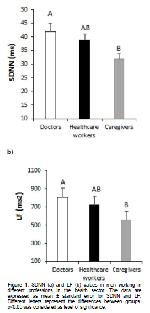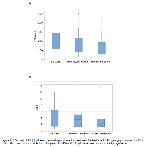Due to the sympathetic and vagal parasympathetic innervations of the heart, HRV is widely used as a marker of the ANS and its two branches
28. HRV is considered one of the most accurate markers of sympathovagal balance in autonomic activity
29. HRV may be used as a tool to predict autonomic imbalances, disease, and mortality
18. In this study, we evaluated time and frequency dependent HRV parameters in male shift staff (doctor, health officer, patient caregiver) working in hospital. In the study, SDNN and LF values were found to be higher in doctors compared to the caregiver group (Figure 1). However, the STAI-2 score was found to be higher in-patient caregiver compared to doctors.
Systolic and diastolic pressures were not statistically significant between the doctor, health officer and patient caregiver groups. In addition, systolic and diastolic pressures were within normal limits in all groups. ANS affects blood pressure through adjustments in parasympathetic and sympathetic activity 30. There is an increasing amount of studies that work stress may be associated with cardiovascular diseases 31. In addition, shift work is a risk factor for cardiovascular disease and hypertension 32. CVD is a leading cause of morbidity and mortality 18. It is known that socioeconomic status also has effects on CVD 33. Poverty has always been associated with poor health, but this may not be the case in modern societies 33. Although the specific contribution of genes and environment is not fully understood, environmental factors and lifestyle are thought to play a more dominant role in the development of CVD 33.
HR was not statistically significant between the doctor, health officer and patient patient caregiver groups. In addition, HR was within normal limits in all groups. HR is under the influence of ANS 34. HR assessment continues to be used as a health indicator from past to present 34. Researchers emphasize that status and work stress are associated with illnesses and poor health 18,31. Studies have shown that high resting heart rate is associated with increased mortality 35. Researchers emphasized in their study that HR increased in acute stress situations, but HR decreased with chronic stress 36. Therefore, there may not have been a difference between the groups because they have been doing this job for years in all three groups.
In our study, SDNN value was found to be lower in the patient caregiver group compared to the doctor group (Figure 1). SDNN is a measure for the evaluation of total sympathetic and parasympathetic activity 37. A higher SDNN value is associated with a higher probability of survival 26. Weakness of ANS can lead to a weakened ability to adapt to difficulties and a decrease in the ability to cope with emotional / physical stress factors 5,38. Low HRV has been associated with conditions such as psychopathology, including anxiety 39. The researchers emphasized in their studies that low SDNN values are associated with both morbidity and mortality 26. HRV time-domain measurements decrease with age 26. Hence, SDNN tends to decrease with advancing age 40. Therefore, the decrease in SDNN value may also be due to the age difference. However, the fact that 20-29 and 30-39 age groups are consecutive in the age groups classification and there is no difference between the groups in 41 terms of other HRV parameters also suggests the possibility that age has less effect on SDNN. Work stress has been associated with reduced HRV 18. Among men, job stress has been associated with low HRV due to recurrent ANS activation 8. In our study, the STAI-2 score was found to be higher in the patient caregiver group compared to the doctor group. Researchers emphasize that status and work stress are associated with illnesses and poor health 18,31. The researchers emphasized in the studies that low HRV is also associated with low socioeconomic status 42. Although social class has an effect on the cardiovascular system, its mechanism of action is not yet understood 42. Studies have shown that reduced education 43, occupational status, and income 43, are all associated with mortality, morbidity, and poor functional status 42. TP was not different in the doctors group compared to the health officer group and the patient caregiver group (Figure 1). TP is a marker of autonomic nervous system activity 44. Higher TP is associated with better health 45.
In our study, there was no difference between the groups in terms of PNN50, RMSSD and HF values. Some of the parasympathetic components of HRV are PNN50, RMSSD and HF 38. Modulation of vagal tone is important for maintaining cardiovascular health 26. Although there are some differences between studies, the consensus is that lower values of vagal function indices are prospectively associated with death and disability (18). High vagal activity is considered cardioprotective and hence associated with better health 46. In our study, there were no difference between the groups in terms of VLF and LF/HF (Figure 1). Normal VLF value correlates with healthy state 26. LF/HF is an indicator of sympathovagal balance 26. An increase in LF/HF ratio indicates predominant sympathetic activity, while a decrease in LF/HF indicates parasympathetic dominance 47.
LF has long been considered a measure of sympathetic activity 47. The origin of LF power, however, has consistent controversy 47. Thomas et al. emphasized in their study that LF and VLF do not represent cardiac sympathetic modulation of the heart and these parameters may reflect vagal mediated baroreflex cardiac effects 47. In our study, the STAI-II score was found to be higher in the patient caregiver group compared to the doctors group. However, the LF value was found to be higher in the doctors group compared to the patient caregiver group. This situation seems to support the predictions of Thomas et al. However, the perception of physiological and psychological stress may be different 48. Although they are STAI and HRV stress parameters, it has been observed that they may give different results in some studies 49.
In our study, the STAI-II score was found to be higher in the patient caregiver group compared to the doctors group. STAI scores are commonly classified as no or low anxiety 20-37, moderate anxiety 38-44, and high anxiety (45-80) 50. While moderate anxiety was observed in the doctors group, there was a high level of anxiety in the patient caregiver group. Among men, work stress has been associated with low HRV due to recurrent ANS activation 8. Stress in the workplace is an important public health risk associated with cardiovascular morbidity 18. CVD is the leading cause of death and disability worldwide 18. Researchers emphasize that status and work stress are associated with illnesses and poor health 18,31. Low socio-economic status (SES) is associated with steadily increasing rates of morbidity and mortality when measured by income, education, or other indicators 51.
As a result, shift work is an important component of the modern world, but has been linked to risk for diseases such as cardiovascular diseases 5. In addition, researchers highlight that job status and stress are also associated with illnesses and poor health 18,30. In our study, SDNN value was found to be higher in the doctor group compared to the patient caregivers group. In addition, the STAI-II score was higher in the patient caregivers group than in the doctor group. These collectively show that, even the doctors work hard and have higher responsibilities; they appear to have better heart rate variability parameters and less stress perception. As a result, the data suggest that job status may have significant effects on health, even in individuals working in the same environment.
Conflict of Interest: The authors declare that they have no conflict of interest.
Funding: There are no financial supports.






